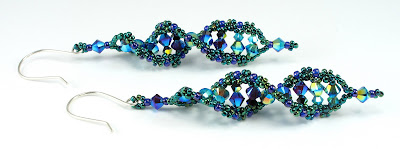The colors and design of the necklace came about from a pair of earrings that I made alongside several other pairs of earrings that I wove for Christmas presents. For this pair, I continued the theme of using larger beads for the purines and smaller beads for the pyrimidines: I used 4 mm bicone crystals for A and G, and 3 mm bicones for C and T. I also added little caps at both ends of the earrings for an aesthetic effect.
The problem with these earrings is that I didn't use a seed bead between the crystals and the DNA backbone, which leaves the thread exiting the crystal at an angle. As any experienced beader will tell you, this can make the thread weaken and snap, which was the case when I made these earrings even though I used the stronger fireline thread instead of a nylon thread. As such, I didn't feel comfortable giving away or selling these earrings, so I kept them for myself.
These earrings needed a matching necklace, so I set out to create a beaded replication fork. For the types of beads used in the DNA itself, I added back in a 15° seed bead between the crystals and the backbone, so that the necklace would be stronger than the earrings. I also decided to forego the variation that yields major and minor grooves that you can see in my gene regulation necklace. The resulting necklace less-accurately portrays real DNA in that respect, but it does look closer to real DNA in another; since I used smaller beads for the backbone (I replaced some of the 11° seed beads with 15° seed beads, and the 8° seed beads with 11° seed beads), and a relatively longer set of beads for the base pairs (approx. 9 mm), there are about 11 base pairs per turn of the beaded double helix. B-DNA has about 10.5 base pairs per turn. In all the variations I've beaded on this design, I've only been able to get up to about 8 base pairs per turn until now. (For more on this subject, take a look at Gwen's two crystal DNA pieces - you can really see the effect of base pair length on helical pitch in these pieces).
I call this necklace a replication fork because it depicts how real DNA is replicated; since each base pair is defined (C always pairs with G and A always pairs with T), each strand has enough information to serve as a template for the other strand. Real DNA replicates this way; the double helix is unwound into single strands, and the new strands are synthesized on to the two older strands, one nucleotide at a time. So in this piece, the older DNA is at the focal point of the necklace, and the newer DNA wraps up the necklace towards the back.
The necklace has a beaded custom toggle clasp, woven with a twist on the embellished RAW technique.
Finally, additional Swarovski bicone crystals and Venetian glass rounds complete the necklace.
The sequence used in this necklace comes from the alpha subunit gene of the E. coli DNA polymerase III complex, which is responsible for most of the DNA synthesis in the E. coli cell. The story of its discovery, 24 years after the first DNA polymerase was characterized, is an interesting lesson in persistence and the methodology needed to solve complicated scientific questions. Plus it's the perfect sequence to use for a depiction of DNA replication :)








I love it, so sparkly and scientific!
ReplyDeleteYour jewelry is amazing, you have great ideas!
ReplyDeleteI can't even say how much I love everything about this necklace. :)
ReplyDeleteThanks everyone! I think science could always use more sparkle :)
ReplyDeleteWhat Rebecca said, times two. Excellent Cindy!
ReplyDeleteFantastic! Please say you can market them, I'd buy one in a heartbeat!
ReplyDeleteThanks Gwen and Leah! I'll have to figure out how much it would cost to make one of these... It has a whole bunch of crystals...
ReplyDeleteThe necklace turned out beautifully and I enjoyed the mini science lesson!
ReplyDeleteThanks Mary! Sometimes I think I get too carried away with my science ramblings, so I'm glad you enjoyed it!
ReplyDeleteI was dazed when i saw photos on the internet. I have never tried beading before, but I decided to try. First I tried original Gwen's pattern for earrings using 0.12mm line, but as a result, my earring did not twisted at all. It lay as railway:
ReplyDeletehttps://s8.postimg.org/7x25mrrph/20170312_163748_0.jpg
https://s4.postimg.org/a3o7jttgd/20170312_162652_0.jpg
Next I tried 0.2mm wire and swarovski cristalls like yours. As a result I can twist it, but the wire is hard to work with and earring turns out to be crooked and acimmentrical.
https://s24.postimg.org/lv1kb4tnp/20170312_163639_0.jpg
https://s9.postimg.org/nq7y6ygsv/20170312_162447_0.jpg
And results shines complitelly not like yours.
That I doing wrong? That materials are you using?
Hi Buka. I'm glad that you like this design. If you're having issues creating these earrings, I recommend contacting Gwen directly to see what pointers she can offer.
Delete